1. Shaktis of God
Innumerable Shaktis of God are in a state of oneness with Him. Amongst them, the following three forms of Shakti are given predominance.
-
Antarang (Internal) : This is said to be the inherent Shakti of Shrinarayan.
-
Tatastha (Neutral) : That Shakti which is neither entirely one nor totally distinct from God is called Tatastha (Neutral). The innumerable living beings in the universe constitute God’s Tatastha Basic Maya can be grossly referred to as this Shakti.
-
Bahirang (External) : Prakruti (Great Illusion) in the form of the universe extending from the Mahatattva (The Great Principle) to the earth along with all worldly objects is called bahirang In other words, bahirang Shakti means everything associated with the Panchamahabhutas [Five Cosmic Elements] from the Saptalok.
2. Forms of Shakti according to mission
2A. Shaktis associated with Creation
The Deities of worship for devotees of Shakti are Shiva and Shakti. They are the parents of the universe. It is by the union of Shiva and Shakti that the universe was created. The first alphabet ‘a’ (अ) and the last one ‘ha’ (ह) of the Devanagari script represent Shiva and Shakti respectively.
Names of Shakti associated with creation
Although, theoretically, Saraswati is associated with Deity Brahma, the Creator of the universe, yet physically, the following Deities are more closely associated with Creation.
Bhudevi, Bhumidevi, Bhumika, Bhairavi, Santeri, Lajjagouri, Lanjika, Mahakoteshwari, Yogambika, Nitambini, Kotari, Chinnamasta etc. are associated with the trunk of Devi Renuka. (The head of Renuka is Yallamma that is Jagadamba.)
Science underlying the Idol
Devis such as Bhudevi are headless. They possess only the breasts and vulva. At times, a lotus or a chakra (Wheel) substitutes the head. For the vulva to appear prominent, the legs are bent and pressed against the abdomen. The breasts signify Sustenance and the vulva represents Creation. Sometimes, a lotus, which is a symbol of procreation, is drawn at the site of the vulva. (A bull is a symbol of masculinity or paternity.)
The objective of worship of these Devis is to beget children.
2B. Shakti associated with Sustenance
They are Shri, Lakshmi, Tripurabhairavi, Bhuvaneshwari, Kamakshi, Tripurasundari, Lalita, Anandbhairavi, Kana kavati, Shakambhari, Annapurna, etc.
Their mission is nurturing and sustaining the universe as well as its manifestation, that is, bestowal of good fortune, prosperity, wealth, longevity and health, progeny, abundant food grain, servants, etc.
2C. Forms of Shakti associated with Dissolution
They are Bhadrakali, Kali, Kalika, Mahamari, Karali, Kapali, Chandika, Ranachandi, Chamunda, Chandi, Nirruti, etc
2D. Forms of Shakti associated with Creation, Sustenance and Dissolution
Shakti associated with Creation, Sustenance and Dissolution is Navadurga. There are nine different dimensions in the nature and a separate form of Shri Durgadevi rules each dimension. There are nine such Durgas and hence they are called ‘Navadurga’.
3. Shakti in the form of rivers
3A. Ganga
The river Ganga originates in the Himalayas at Gangotri and culminates in Bay of Bengal through its tributaries. It stretches along 2,510 kilometres.
Origin and meaning
-
‘गमयति भगवत्पदमिति गङ्गा ।’, that is, गङ्गा means – one who elevates (the bathing embodied soul) to the state of the Deity is the Ganga.
-
‘गम्यते प्राप्यते मोक्षार्थिभिरिति गङ्गा ।’, means – one to whom those desirous of Liberation turn to is the Ganga.
Some other Names
-
Vishnupadi : Deity Brahma washed the feet of Shrivishnu with the water from His Kamandalu (Water pot). It was from this water that the Ganga originated and thus came to be known as Vishnupadi (Pad means feet). This is the concept regarding the origin of the Ganga according to the Vaishnav
-
Tripathaga : She is called so because She flows through all the three regions – heaven, earth and hell (Tri means three and patha means path).
-
Bhagirathi : It was because of austerities undertaken by Bhagirath that this river descended onto earth. Hence, the river is named after him. The slogan during ritualistic bathing in the Ganga is ‘Hail, O Ganga, Bhagirathi (हर गङ्गे भागीरथि ।)’. According to the Shaiva sect, Bhagirath pleased Deity Shiva with his austerities. To prevent the earth from breaking into two due to the force of the current of the Ganga flowing from heaven, Deity Shiva took Ganga upon His head. From there, She made a gradual descent onto the earth, at Gangotri in Bharat.
-
Janhavi : While flowing down the Himalayas, the Ganga swept away Sage Janhu’s site for performing sacrificial fires. This enraged the Sage who swallowed Her stream in its entirety. Then Bhagirath prayed to Sage Janhu. Consequently, He released the waters of the Ganga through His ear. That is how Ganga came to be known as Janhavi (the daughter of Janhu)
Unique characteristics and importance
-
Holy : It is the holiest among all the seven Holy rivers in Bharat. Should any water in the world be compared to the water of the Ganga, those who can perceive the subtle dimension will realise that the latter is holier. One can perform this experiment at home. The words impure and unholy are not synonymous. Pure and impure are in relation to the body or the physical sciences; whereas, Holy and unholy are in relation to the science of Spirituality. Thus, an object can be impure yet Holy. The water of the Ganga today is similar to this. This water can lead to illnesses, yet one benefits because of its Sattvaguna. However, pure and Holy water is certainly the best.
-
The one bringing about spiritual evolution : Since the Ganga causes spiritual upliftment of the downtrodden, it is used to cleanse sins in the following ways.
गङ्गा गङ्गेति यो ब्रूयात् योजनानां शतैरपि ।
मुच्यते सर्वपापेभ्यो विष्णुलोकं स गच्छति ॥Meaning : If one utters the Holy name of Ganga like ‘Ganga….Ganga…’ even from a hundred ojanas (Scale to measure distance), one is absolved of all the sins and at last he reaches the abode of Vishnu.
To attain better afterlife, water from the Ganga is poured into the mouth of an individual on his deathbed. It is due to this that water from the Ganga is preserved in every household. (If this is not available, then water with tulsi leaves soaked in it is used.)
-
Ability to destroy germs : Dr E Hanbury Hankin’s research of the 19th century is associated with the disinfecting / antiviral power of Ganga’s water. Hankin (1896) reported that cholera microbes did not survive for long in the Ganga waters. It has been proved scientifically that like cholera, the germs of plague, malaria, etc. also cannot survive in the water of Ganga. It has also been proved that by drinking Ganga water everyday, resistance against diseases increases and illnesses such as indigestion, long-standing fever, diarrhoea, dysentery, asthma, etc. are gradually cured. Ganga water has the potential to heal a wound. Even as per Ayurveda, the Ganga water has many outstanding medicinal values.
3B. Narmada
This river originates in the mountain named Mekal from the Vindhya mountain range and meets the Arabian Sea at Bhrugukachh (Bharuch) in Gujarat, in Bharat. It stretches 1288 kilometres.
Unique characteristics and importance
-
She is associated with the Tejtattva (Absolute Fire Principle). Hence, many hathayogis have undertaken austerities on its banks and continue to do so even today.
-
She is considered the Sushumnanaḍi (The central channel of the spiritual energy flow system) of the Kunḍalini system of the earth. Hence, in many a religious ritual, a mention is made whether the ritual is being performed to the north or the south of the river Narmada. The northern or southern sides of the Narmada are respectively akin to the Pingala (Surya or Sun) or Ida (Chandra or Moon) channels (Naḍis) according to the Kunḍaliniyoga (Path of activation of spiritual energy).
-
The 108 waves, which descend onto the earth from the universe, do so at 108 different places. These are referred to as108 places of pilgrimage (Known as tirthakshetras). In the same way, some of the 108 waves reach the earth through the river Narmada and then spread throughout the world. Hence, it is called the ‘Umbilical cord of earth’.
-
Narmada is associated with vairagya (Detachment).
Worship
Just as one circumambulates the Deities, Narmada is the only river in the world that is circumambulated by people as their spiritual practice, starting from its origin to its confluence with the ocean and then return to its origin without crossing the river. Even today, many seekers have the spiritual experience that in the course of their circumambulation (or pilgrimage) through forests and remote unpopulated regions, the river Deity provides them with food and never lets them go hungry.
Some other Holy rivers are Yamuna, Godavari, Saraswati, Sindhu and Kaveri. River Ganga is associated with knowledge, while river Yamuna with devotion.
Reference : Sanatan Sanstha’s Holy text ‘Shakti (Part 1) Introduction to Divine Energy’ and ‘Shakti (Part 2) Worship of Divine Energy’

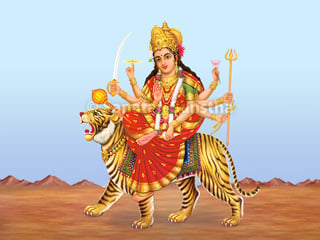
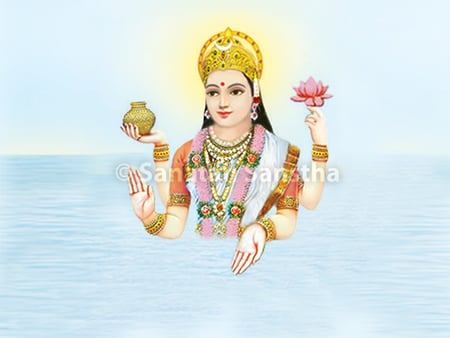
 Frequently Asked Questions on Kuladev and Kuldevi
Frequently Asked Questions on Kuladev and Kuldevi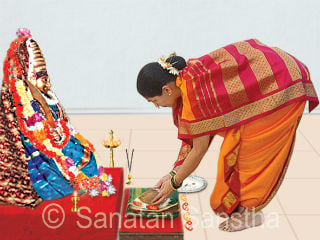 What is importance of 'offering a sari' for the Goddess?
What is importance of 'offering a sari' for the Goddess?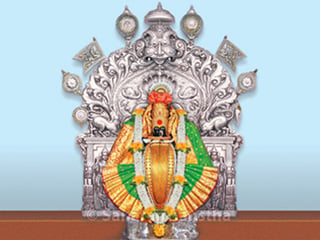 Seats of Shakti (Shakti-peeth)
Seats of Shakti (Shakti-peeth)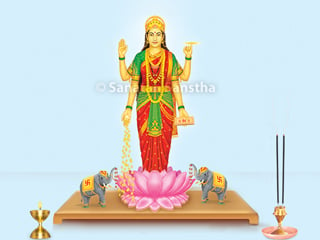 Shakti Worship
Shakti Worship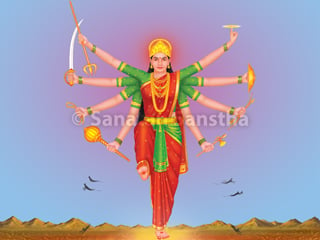 Shakti associated with Shiva - Parvati
Shakti associated with Shiva - Parvati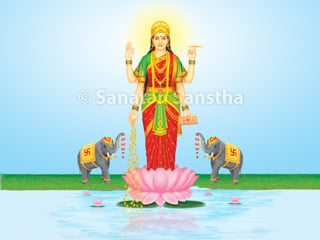 Shakti associated with Shrivishnu - Shri Lakshmi
Shakti associated with Shrivishnu - Shri Lakshmi